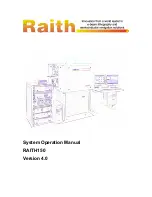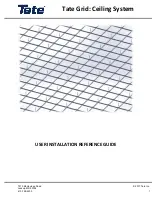
Page 2 of 8
NOTICE
It is the responsibility of the owner/user to install, inspect, test, maintain, and operate a clamp in accordance with ANSI/ASME B30.20,
“Safety Standard for Below-the-Hook Lifting Devices” and ANSI/ASME B30.16, “Safety Standard for Overhead Hoists”. If the clamp is
installed as part of a total lifting system, such as an overhead hoist, crane or monorail, it is also the responsibility of the owner/user to
comply with the applicable ANSI/ASME B30 volume that addresses that type of equipment.
It is the responsibility of the owner/user to have all personnel that will install, inspect, test, maintain, and operate a clamp read the
contents of this manual and applicable portions of ANSI/ASME B30.20, “Safety Standard for Below-the-Hook Lifting Devices”,
ANSI/ASME B30.16, “Overhead Hoists (Underhung)” and OSHA Regulations. If the clamp is installed as part of a total lifting system,
such as an overhead hoist, crane or monorail, it is also the responsibility of the owner/user to comply with the applicable ANSI/ASME
B30 volume that addresses that type of equipment.
If the clamp owner/user requires additional information, or if any information in the manual is not clear, contact Harrington or the
distributor of the clamp. Do not install, inspect, test, maintain, or operate this clamp unless this information is fully understood.
A regular schedule of inspection of the clamp in accordance with the requirements of ANSI/ASME B30.20 and ANSI/ASME B30.16
should be established and records maintained.
2.0 Technical Information
2.1 Specifications
2.1.1 Operating Conditions and Environment:
Temperature Range: -4° to +140°F
(-20°C
to
+60°C)
Humidity: 100% or less
This is not underwater device.
Material: No special materials such as spark
resistant.
Do Not Use: In an alkaline/acidic or an organic solvent/explosive atmosphere.
2.1.2 Clamp
Specifications:
Product
Code
UBC010 UBC020 UBC030 UBC050 UBC100
Capacity
(Ton)
1 2 3 5 10
Flange Range (in)
3.00 to 7.50
3.00 to 7.50
4.00 to 12.00
4.00 to 12.00
6.00 to 13.25
Max. Beam Flange Thickness (in)
0.83
0.83
1.00
1.00
1.75
Net Weight (lbs)
8
9
19
22
55
3.0 Preoperational Procedures
3.1 Mounting
Location
3.1.1
WARNING
When used as a suspension device, ensure that the suspension and the supporting structure is adequate to support
the clamp, the hoist and its loads. If necessary consult a professional that is qualified to evaluate the adequacy of the suspension
location and its supporting structure.
3.1.2
WARNING
When used as a below the hook lifting device, ensure that the load’s attachment point is able to support the weight of
the load and the load is able to withstand the gripping force of the clamp without deforming or breaking.
3.2 Optional
Suspender
3.2.1 Refer to Parts List in
section 8.0
for installation of optional suspender parts.
3.3 Mounting/Using the Clamp
3.3.1 Mount the beam clamp to a supporting structure over work area. Position the jaws over the lower beam flange and tighten the
clamp by rotating the clamp handle clockwise to secure it in place.
3.3.2 For use of the clamp as a lifting device, suspend the clamp from the hoist bottom hook. Position the load in between the jaws and
tighten the clamp by rotating the handle clockwise. Be sure that the load is fixed in between the clamp jaws securely. The clamp
should be attached to the load at a place to ensure the load is evenly distributed and balanced.
3.3.3
WARNING
Ensure that the fixed suspension point rests on the center of the hook’s saddle and that the hook’s latch is engaged.
3.3.4 Use lock nut for all applications. Ensure the clamp is securely positioned and tightened, and tighten the lock nut. Ensure that at
least one thread is exposed beyond the nut.
3.4 Preoperational Checks and Trial Operations
3.4.1
WARNING
Confirm the adequacy of the rated capacity for all clamps and all other components of lifting system before use.
Inspect all load suspension members for damage prior to use and replace or repair all damaged parts.
3.4.2 Record the clamp's Code and Serial Number (from the name plate on the clamp; see
Section 8.0
) in the space provided on the
cover of this manual.
3.4.3 Ensure that the clamp is properly installed to a fixed point.
3.4.4 Ensure that all nuts and bolts are sufficiently fastened. (Continued on next page)


























